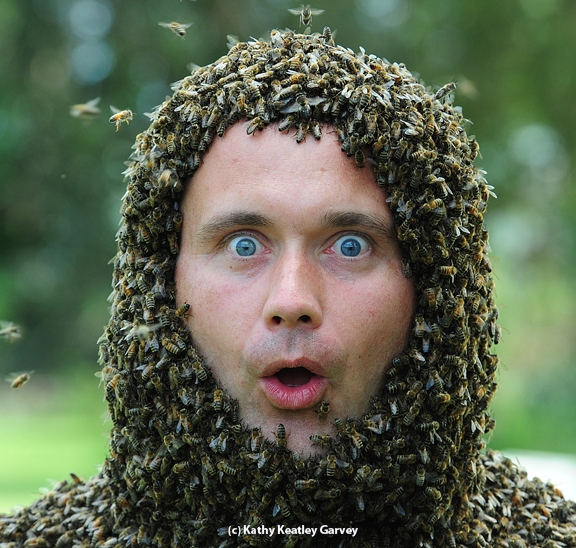To bee or not to bee?
That was not the question. There was no question. The answer was "yes" before the event began.
When visiting bee scientist Jakub Gabka of Warsaw, Poland, studied at the Harry H. Laidlaw Jr. Honey Bee Research Facility at UC Davis last summer with noted bee breeder-geneticist Susan Cobey, she held a bee beard event for the Laidlaw crew.
Gabka struck this pose--which graces the cover of the current edition of American Bee Journal.
How did it feel? It’s heavy, it's hot, and it tickles, he said.
Cobey, now a bee researcher at Washington State University (she also teaches queen bee insemination classes and queen bee rearing classes), loves doing bee beard events.
It’s an educational and entertaining activity best done in the spring when the nectar flow is heavy, when the temperatures are optimum, and when the bees “are fat and happy,” she says.
You do not want to try this at home. Only beekeepers should do this, and with a seasoned bee beard coordinator. Proper knowledge, preparations and training of the bees are crucial. A novice, unaccustomed to being around bees, might freak out. Literally.
“The fact that honey bees are venomous insects with the ability to sting when threatened, must be respected,” Cobey says.
Cobey has organized bee beard venues at a number of places, including Ohio State University’s Rothenbuhler Honey Bee Laboratory and the Laidlaw facility (her former workplaces), and in Washington state, where she and her husband, Tim Lawrence, a county Extension director, now reside. (See her research lecture, "Enhancing Genetic Diversity in the U.S. Honey Bee Gene Pool" on the Lewis County (Wash.) Beekeepers' Association website), along with more bee beard photos.)
Beekeepers are passionate about their fascination with honey bees, Cobey acknowledges. "The ultimate beekeeping experience is getting intimate with bees and literally looking a bee in the eye."
Cobey will be writing a "how to" piece on bee bearding in the near future.
Meanwhile, if a photo is worth a thousand words, what is a photo of thousands of bees on your head worth?
Priceless.
Attached Images:
